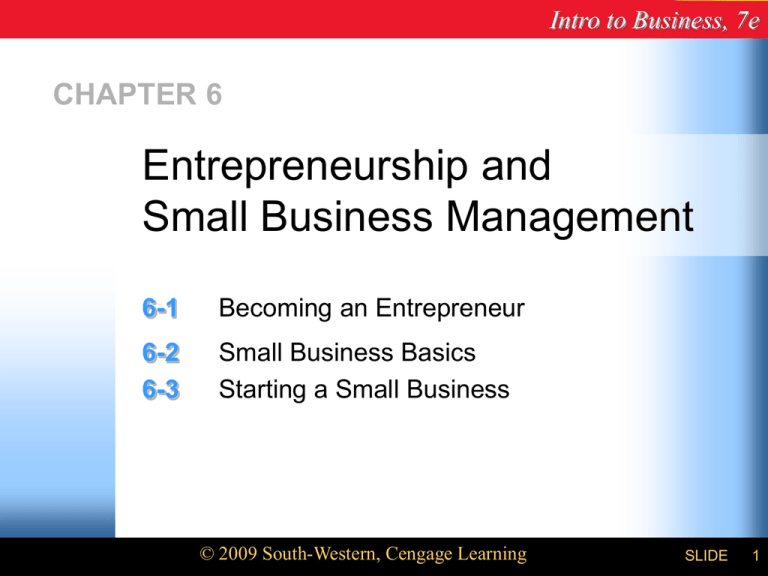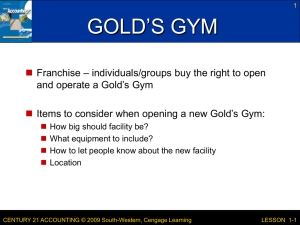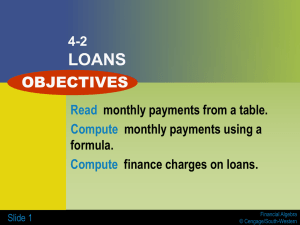Entrepreneurship and Small Business Management
advertisement

Intro to Business, 7e CHAPTER 6 Entrepreneurship and Small Business Management 6-1 Becoming an Entrepreneur 6-2 6-3 Small Business Basics Starting a Small Business © 2009 South-Western, Cengage Learning SLIDE 1 Intro to Business, 7e 6-1 Becoming an Entrepreneur Goals Identify characteristics of successful entrepreneurs. Recognize the importance of entrepreneurship in the economy. Describe opportunities and risks of entrepreneurship. © 2009 South-Western, Cengage Learning SLIDE 2 Intro to Business, 7e Chapter 6 Key Terms entrepreneur entrepreneurship venture capital innovation improvement © 2009 South-Western, Cengage Learning SLIDE 3 Intro to Business, 7e Chapter 6 CHARACTERISTICS OF ENTREPRENEURS Desire to be your own boss Special skills and abilities © 2009 South-Western, Cengage Learning SLIDE 4 Intro to Business, 7e Chapter 6 ENTREPRENEURS IN ACTION Pankaj Arora Rich Stachowski Jeffrey Rodriguez and John Serrano Abbey Fleck © 2009 South-Western, Cengage Learning SLIDE 5 Intro to Business, 7e Chapter 6 WHAT DOES IT TAKE? Entrepreneurs are more persistent inquisitive energetic goal oriented independent self-confident creative reliable competitive © 2009 South-Western, Cengage Learning SLIDE 6 Intro to Business, 7e Chapter 6 WHAT DOES IT TAKE? (continued) Entrepreneurs have problem-solving skills tolerance for ambiguity strong integrity personal initiative ability to secure resources capability to learn from failure willingness to work hard © 2009 South-Western, Cengage Learning SLIDE 7 Intro to Business, 7e Chapter 6 Checkpoint >> What personal characteristic are common to most successful entrepreneurs? Answer Any characteristics listed in Figure 6-1 are acceptable, such as persistence, inquisitiveness, self-confidence, creativity, and so forth. © 2009 South-Western, Cengage Learning SLIDE 8 Intro to Business, 7e Chapter 6 ENTREPRENEURSHIP AND THE ECONOMY Employment Financing Productivity © 2009 South-Western, Cengage Learning SLIDE 9 Intro to Business, 7e Chapter 6 Source: U.S. Bureau of Labor Statistics Employment Growth by Business Size © 2009 South-Western, Cengage Learning SLIDE 10 Intro to Business, 7e Chapter 6 Checkpoint >> What are the sources of financing that entrepreneurs use for their new businesses? Answer personal savings friends and family venture capital bank loans © 2009 South-Western, Cengage Learning SLIDE 11 Intro to Business, 7e Chapter 6 OPPORTUNITIES Innovation Improvement © 2009 South-Western, Cengage Learning SLIDE 12 Intro to Business, 7e Chapter 6 RISKS Recognizing risks Lack of adequate capital Low sales Higher than expected expenses Competitive pressure An owner unprepared to manage a growing business Operations requiring more time than the owner is willing to commit © 2009 South-Western, Cengage Learning SLIDE 13 Intro to Business, 7e Chapter 6 Checkpoint >> Where do entrepreneurship opportunities begin? Answer Opportunities begin with innovations (ideas about new products and services) or improvements (ideas for changes to existing products, services, or processes). © 2009 South-Western, Cengage Learning SLIDE 14 Intro to Business, 7e 6-2 Small Business Basics Goals Identify important characteristics of small businesses. Recognize the competitive advantages of small businesses. Identify problems faced by many small businesses. © 2009 South-Western, Cengage Learning SLIDE 15 Intro to Business, 7e Chapter 6 Key Terms small business Small Business Administration (SBA) © 2009 South-Western, Cengage Learning SLIDE 16 Intro to Business, 7e Chapter 6 SMALL BUSINESS OWNERSHIP Description of a small business Owner is usually the manager Operates in one or very few locations Typically serves a small market Not dominant in its field Small business employment Ownership diversity © 2009 South-Western, Cengage Learning SLIDE 17 Intro to Business, 7e Chapter 6 COMMON TYPES OF SMALL BUSINESSES Source: Small Business Administration and U.S. Census Bureau Common Types of Small Businesses © 2009 South-Western, Cengage Learning SLIDE 18 Intro to Business, 7e Chapter 6 Checkpoint >> What percentage of employees in the United States work for small businesses? Answer Nearly 50 percent of the American workforce is employed by small businesses. Small businesses are also responsible for 60–80 percent of all new jobs. © 2009 South-Western, Cengage Learning SLIDE 19 Intro to Business, 7e Chapter 6 SMALL BUSINESS ADVANTAGES Meeting customer needs Providing unique services © 2009 South-Western, Cengage Learning SLIDE 20 Intro to Business, 7e Chapter 6 Checkpoint >> How can small businesses compete successfully with larger businesses? Answer Smaller businesses are able to provide more personalized products and services to their customers. They are able to provide products and services where smaller orders and projects are required and tend to fill unique customer needs, which larger companies do not provide. © 2009 South-Western, Cengage Learning SLIDE 21 Intro to Business, 7e Chapter 6 COMMON REASONS FOR SMALL BUSINESS FAILURE Not keeping adequate records Not having enough start-up money Lack of management experience Lack of experience with the type of business Not controlling operating expenses Poor location for the business Failure to manage credit offered to customers © 2009 South-Western, Cengage Learning SLIDE 22 Intro to Business, 7e Chapter 6 SMALL BUSINESS ASSISTANCE Faculties of universities and colleges Local groups of business people Small Business Administration (SBA) © 2009 South-Western, Cengage Learning SLIDE 23 Intro to Business, 7e Chapter 6 Checkpoint >> List common reasons for small business failure. Answer not keeping adequate records insufficient start-up money lack of management experience lack of experience with the type of business not controlling operating expenses poor location failure to manage credit © 2009 South-Western, Cengage Learning SLIDE 24 Intro to Business, 7e 6-3 Starting a Small Business Goals Recognize important factors to be considered when starting a business. Describe the elements of a business plan. Identify types and sources of financing for a small business. © 2009 South-Western, Cengage Learning SLIDE 25 Intro to Business, 7e Chapter 6 Key Terms business plan start-up financing short-term financing long-term financing © 2009 South-Western, Cengage Learning SLIDE 26 Intro to Business, 7e Chapter 6 THE BUSINESS DECISION An idea plus experience Right place and time Team approach Preparation and research © 2009 South-Western, Cengage Learning SLIDE 27 Intro to Business, 7e Chapter 6 Checkpoint >> Why is it important to use a team approach when starting a new business? Answer A team approach allows employees to feel valued and motivated to take personal responsibility for the benefit of the business. Owners cannot expect to be able to do everything alone. Building a team will allow the business to increase productivity and, ultimately, profits. © 2009 South-Western, Cengage Learning SLIDE 28 Intro to Business, 7e Chapter 6 WHAT IS A BUSINESS PLAN? A business plan is a written description of the business idea and how it will be carried out, including all major business activities. © 2009 South-Western, Cengage Learning SLIDE 29 Intro to Business, 7e Chapter 6 ELEMENTS OF A BUSINESS PLAN Description of the Business The business idea Major products and services Ownership structure Strengths/weaknesses Long- and short-term goals © 2009 South-Western, Cengage Learning SLIDE 30 Intro to Business, 7e Chapter 6 ELEMENTS OF A BUSINESS PLAN (continued) Description of Competition Characteristics of the industry Condition of the economy Strengths and weaknesses of major competitors © 2009 South-Western, Cengage Learning SLIDE 31 Intro to Business, 7e Chapter 6 ELEMENTS OF A BUSINESS PLAN (continued) Customer Analysis Description of customers Location, number, and resources of customers Sales forecasts © 2009 South-Western, Cengage Learning SLIDE 32 Intro to Business, 7e Chapter 6 ELEMENTS OF A BUSINESS PLAN (continued) Operations Plan Organization of the company Description of major operations Analysis of resources needed Human resource plans © 2009 South-Western, Cengage Learning SLIDE 33 Intro to Business, 7e Chapter 6 ELEMENTS OF A BUSINESS PLAN (continued) Marketing Plan Description of major marketing activities Description of resources needed Schedule of marketing activities © 2009 South-Western, Cengage Learning SLIDE 34 Intro to Business, 7e Chapter 6 ELEMENTS OF A BUSINESS PLAN (continued) Financial Plans Start-up costs Short- and long-term financial needs Sources of financing Budgets and financial statements © 2009 South-Western, Cengage Learning SLIDE 35 Intro to Business, 7e Chapter 6 STEPS IN DEVELOPING THE BUSINESS PLAN Gather and review information Develop the strategic alternatives Write the plan Ask an expert to review the plan © 2009 South-Western, Cengage Learning SLIDE 36 Intro to Business, 7e Chapter 6 Checkpoint >> What is the “strategic alternatives” in a business plan? Answer Strategic alternatives are alternative plans for production, staffing, financing, and so on. Even the best business plan cannot predict every possible circumstance. An alternate plan allows a business to be prepared for the unforeseeable. © 2009 South-Western, Cengage Learning SLIDE 37 Intro to Business, 7e Chapter 6 FINANCING THE SMALL BUSINESS Types of financing Start-up financing Short-term financing Long-term financing Sources of financing Owner-supplied funds Borrowed funds © 2009 South-Western, Cengage Learning SLIDE 38 Intro to Business, 7e Chapter 6 Checkpoint >> In addition to owner-supplied capital, what are several other sources of financing for a small business? Answer Borrowed money may come from banks, finance companies, or other individuals, such as friends and family. Some suppliers may also be willing to extend credit. © 2009 South-Western, Cengage Learning SLIDE 39








